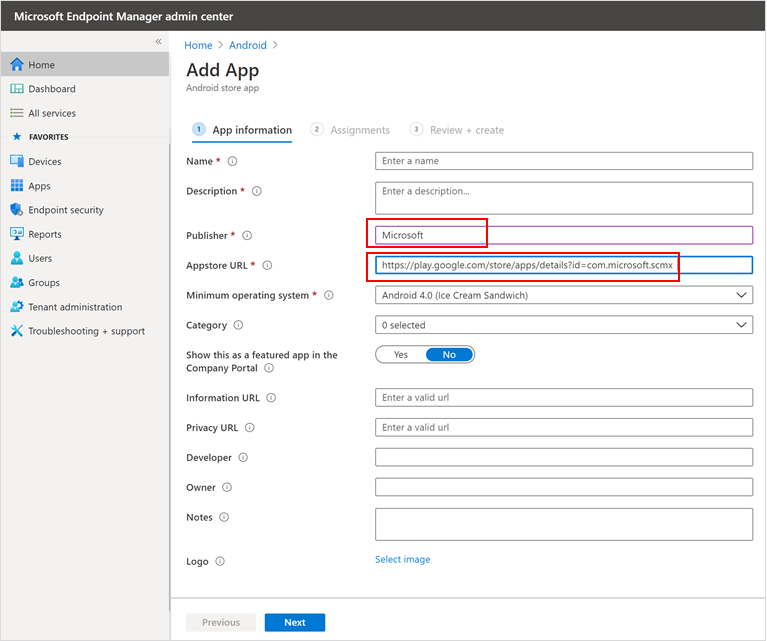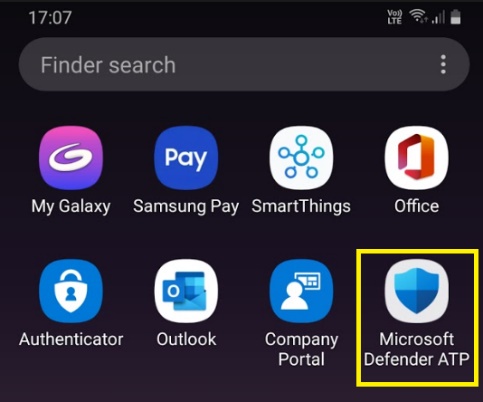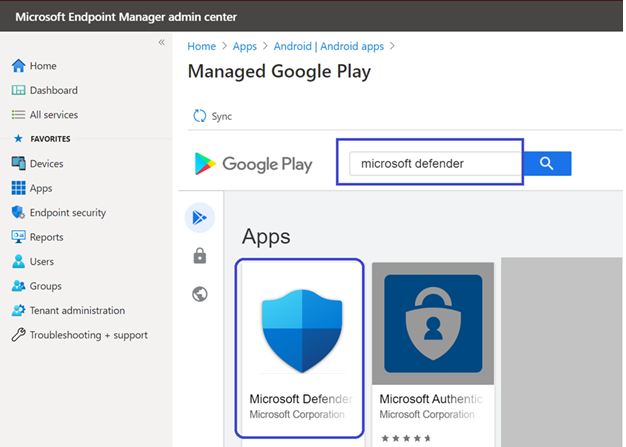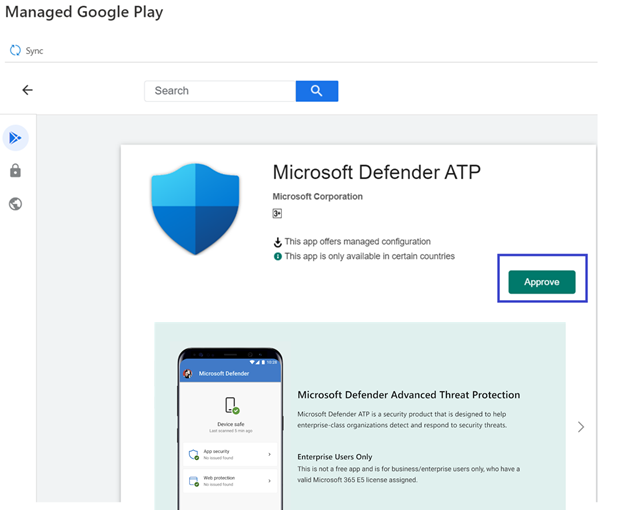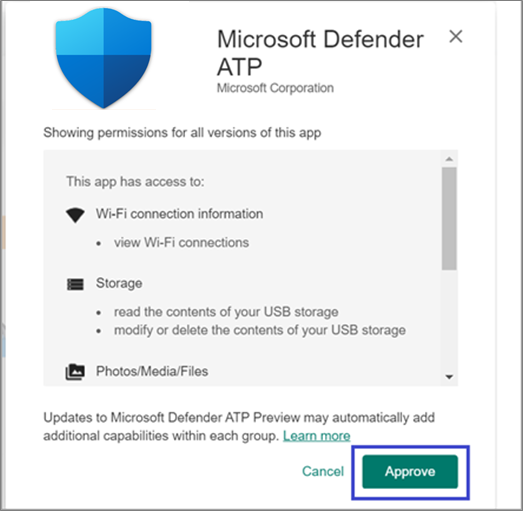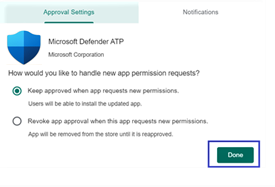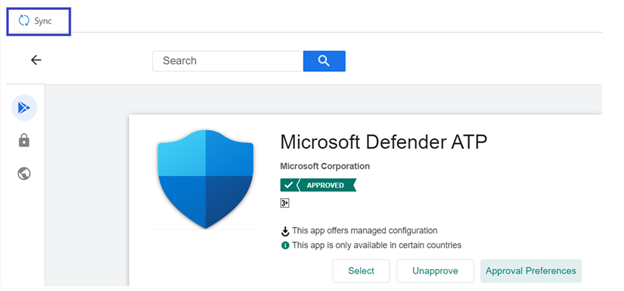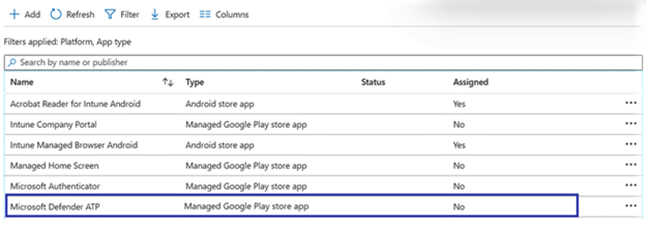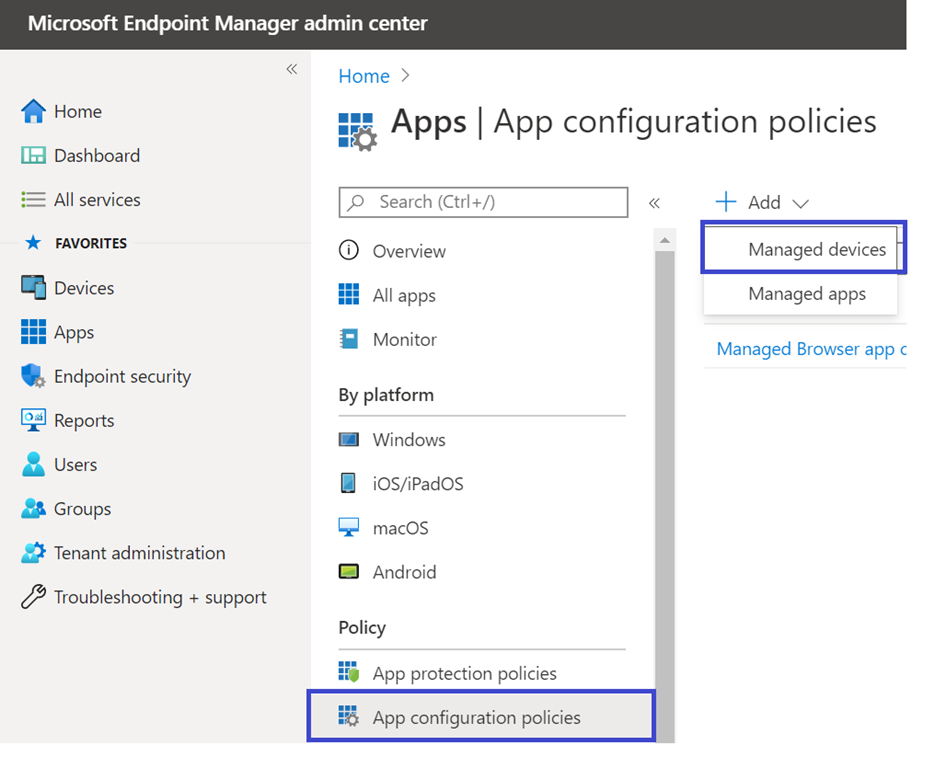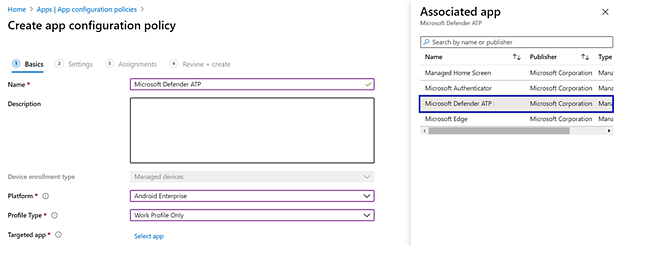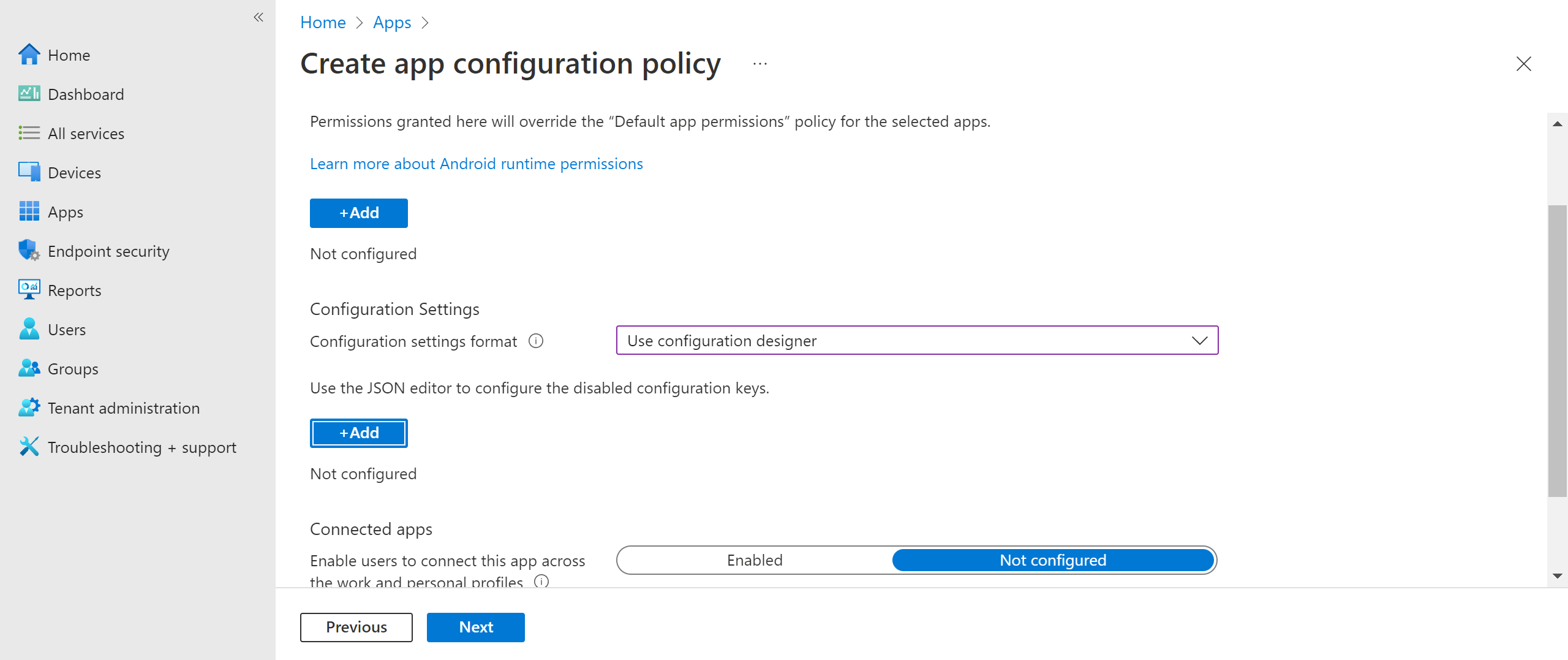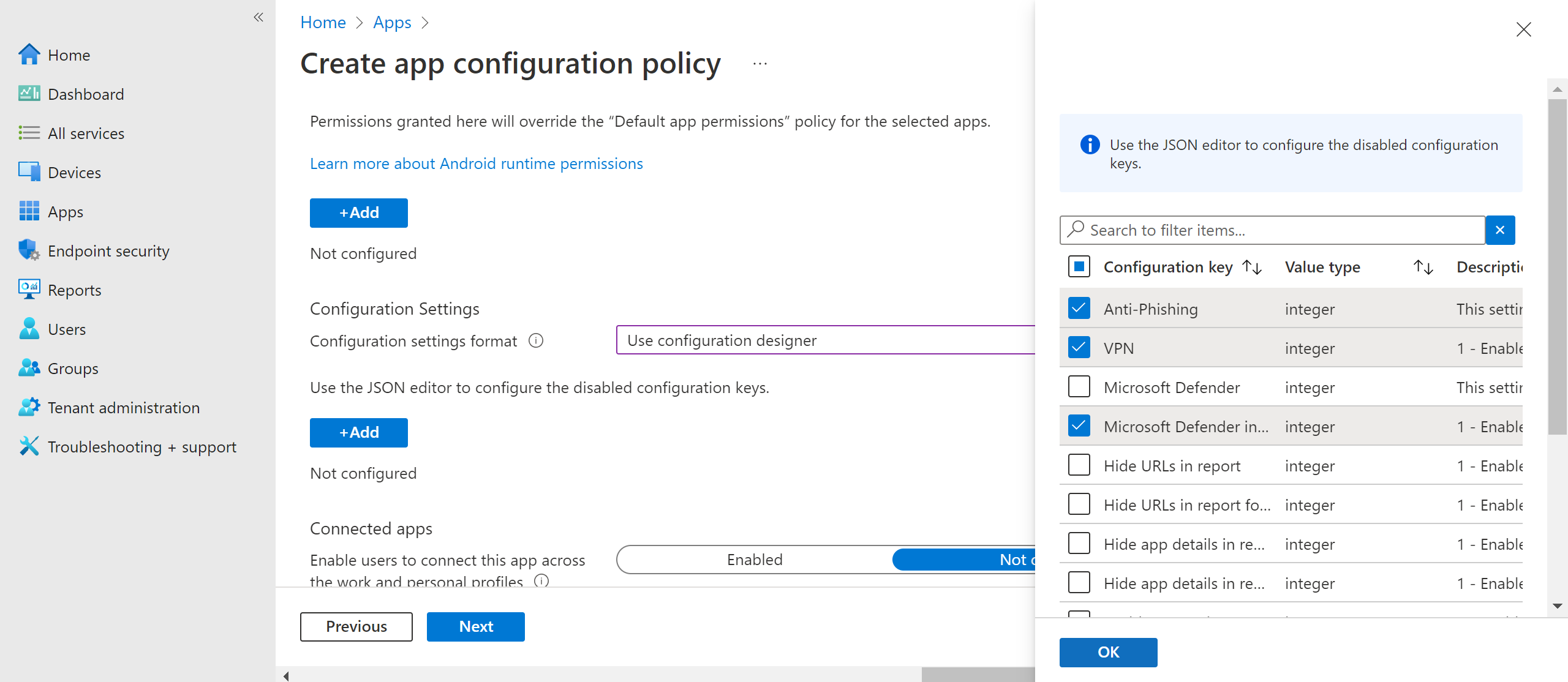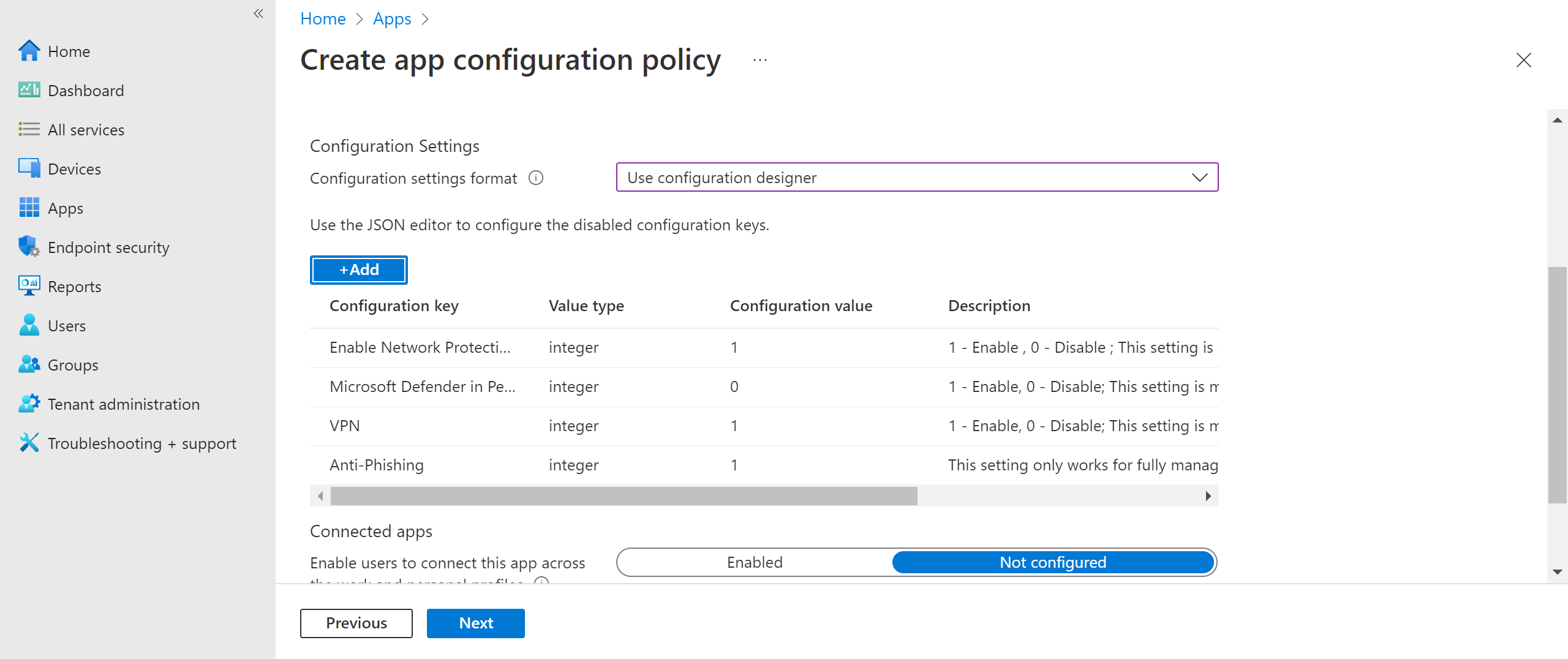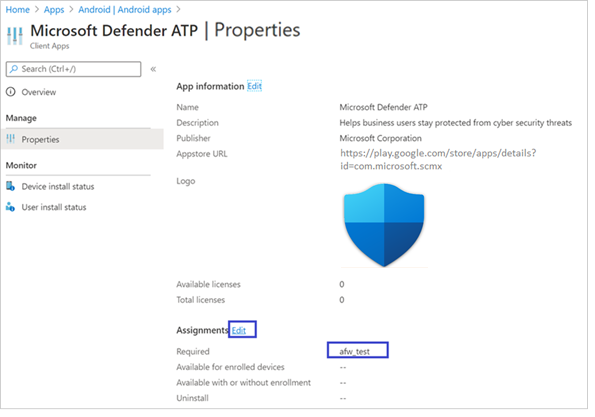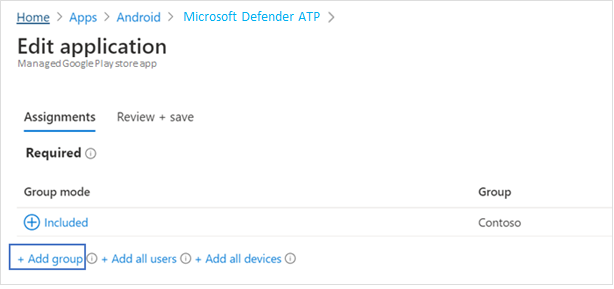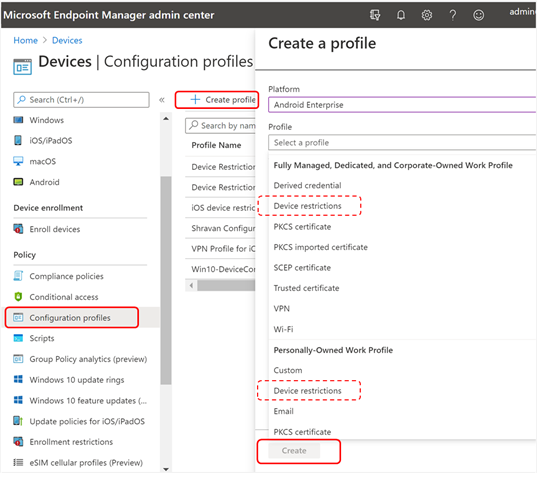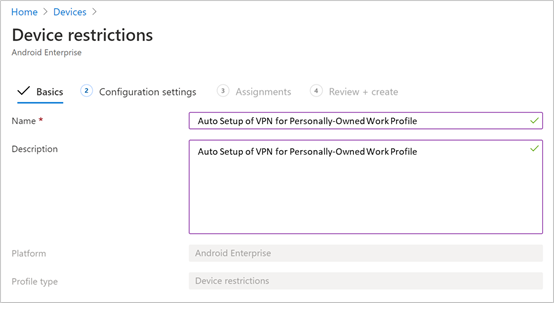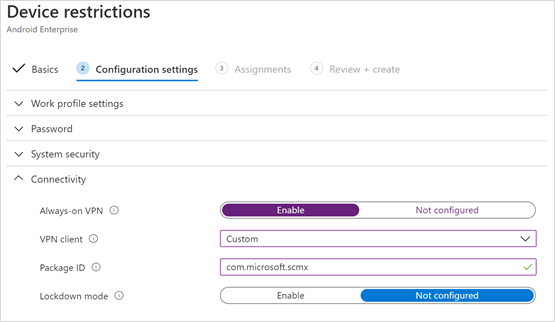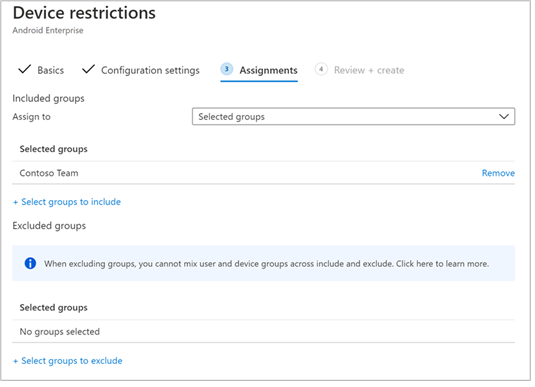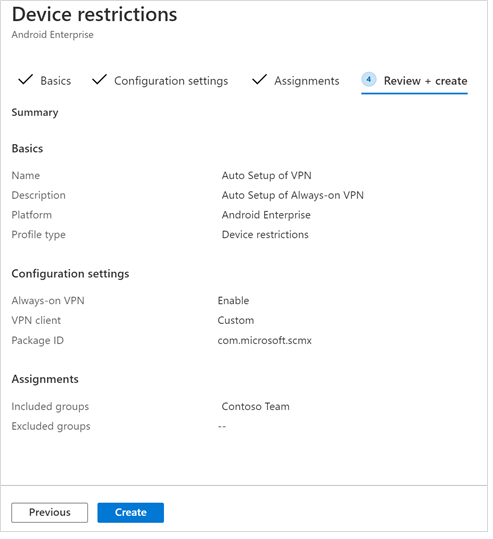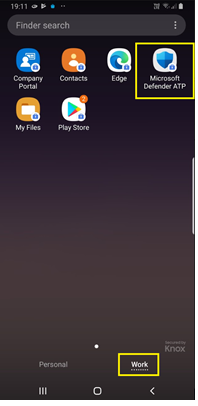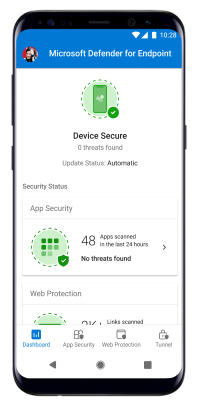Deploy Microsoft Defender for Endpoint on Android with Microsoft Intune
Applies to:
- Microsoft Defender for Endpoint Plan 1
- Microsoft Defender for Endpoint Plan 2
- Microsoft Defender XDR
Want to experience Microsoft Defender for Endpoint? Sign up for a free trial.
Learn how to deploy Defender for Endpoint on Android on Microsoft Intune Company Portal enrolled devices. For more information about Microsoft Intune device enrollment, see Enroll your device.
Note
Defender for Endpoint on Android is now available on Google Play
You can connect to Google Play from Microsoft Intune to deploy Defender for Endpoint app across device administrator and Android Enterprise enrollment modes. Updates to the app are automatic via Google Play.
Deploy on Device Administrator enrolled devices
Learn how to deploy Defender for Endpoint on Android by using the Microsoft Intune Company Portal for device administrator enrolled devices.
Add as Android store app
In the Microsoft Intune admin center , go to Apps > Android Apps > Add > Android store app. Then choose Select.
On the Add app page, in the App Information section specify the following details:
- Name
- Description
- Publisher as Microsoft.
- App store URL as
https://play.google.com/store/apps/details?id=com.microsoft.scmx(URL for the Defender for Endpoint app in the Google Play Store)
Other fields are optional. Then select Next.
In the Assignments section, go to the Required section and select Add group. You can then choose the user group (or groups) to receive the Defender for Endpoint on Android app. Choose Select, and then tap Next.
The selected user group should consist of Intune enrolled users.
In the Review+Create section, verify that all the information entered is correct, and then select Create.
In a few moments, the Defender for Endpoint app should be created, and a notification should appear in the upper right corner of the screen.
In the app information page that is displayed, in the Monitor section, select Device install status to verify that the device installation completed successfully.
Complete onboarding and check status
After Defender for Endpoint on Android is installed on the device, you should see the app icon.
Tap the Microsoft Defender for Endpoint app icon, and follow the on-screen instructions to complete onboarding. The details include end-user acceptance of Android permissions required by Defender for Endpoint on Android.
Upon successful onboarding, the device shows up in the list of devices in the Microsoft Defender portal.
Deploy on Android Enterprise enrolled devices
Defender for Endpoint on Android supports Android Enterprise enrolled devices.
For more information on the enrollment options supported by Microsoft Intune, see Enrollment Options.
Currently, personally-owned devices with a work profile, corporate-owned devices with a work profile, and corporate-owned, fully managed user device enrollments are supported in Android Enterprise.
Add Microsoft Defender for Endpoint on Android as a Managed Google Play app
Follow the steps below to add Microsoft Defender for Endpoint app into your managed Google Play Store.
In Microsoft Intune admin center , go to Apps > Android Apps > Add and select Managed Google Play app.
On your managed Google Play page that loads, go to the search box and type
Microsoft Defender. Your search should display the Microsoft Defender for Endpoint app in your Managed Google Play Store. Select the Microsoft Defender for Endpoint app from the list of search results.In the App description page, you should be able to see app details about the Defender for Endpoint app. Review the information on the page, and then select Approve.
When you're prompted to approve permissions for Defender for Endpoint obtains, review the information, and then select Approve.
On the Approval settings page, review your preference to handle new app permissions that Defender for Endpoint on Android might ask. Review the choices, and then select your preferred option. Then, select Done.
By default, managed Google Play selects Keep approved when app requests new permissions.
After the permissions handling selection is made, select Sync to sync Microsoft Defender for Endpoint to your apps list.
The sync completes in a few minutes.
Select the Refresh button in the Android apps screen. Microsoft Defender for Endpoint should be visible in the apps list.
Defender for Endpoint supports app configuration policies for managed devices using Microsoft Intune. This capability can be used to select different configurations for Defender for Endpoint.
In the Apps page, go to Policy > App configuration policies > Add > Managed devices.
In the Create app configuration policy page, specify the following details:
Select Permissions > Add. From the list, select the available app permissions > OK.
Select an option for each permission to grant with this policy:
- Prompt - Prompts the user to accept or deny.
- Auto grant - Automatically approves without notifying the user.
- Auto deny - Automatically denies without notifying the user.
Go to the Configuration settings section, and choose Use configuration designer.
Select Add to view a list of supported configurations. Select the required configuration, and then select Ok.
You should see all the selected configurations listed. You can change the configuration value as required and then select Next.
In the Assignments page, select the user group to which this app config policy would be assigned. Select Select groups to include, select a group, and then select Next. The group selected here is usually the same group to which you would assign Microsoft Defender for Endpoint Android app.
In the Review + Create page that comes up next, review all the information, and then select Create.
The app configuration policy for Defender for Endpoint is now assigned to the selected user group.
Select Microsoft Defender app in the list > Properties > Assignments > Edit.
Assign the app as a required app to a user group. It's automatically installed in the work profile during the next sync of the device via Company Portal app. Navigate to the Required section, select Add group, select the appropriate user group, and then choose Select.
In the Edit Application page, review all the information that was specified earlier. Select Review + Save, and then select Save to commence assignment.
Auto setup of always-on VPN
Defender for Endpoint supports device configuration policies for managed devices with Microsoft Intune. This capability enables you to use auto setup of always-on VPN on Android Enterprise enrolled devices, so the end user doesn't need to set up a VPN service while onboarding.
On Devices, select Configuration Profiles > Create Profile > Platform > Android Enterprise. Select Device restrictions under one of the following, based on your device enrollment type:
- Fully Managed, Dedicated, and Corporate-Owned Work Profile
- Personally owned Work Profile
Then, select Create.
Configuration Settings. Provide a Name and a Description to uniquely identify the configuration profile.
Select Connectivity, and then configure your VPN.
Enable Always-on VPN. Set up a VPN client in the work profile to automatically connect and reconnect to the VPN whenever possible. Only one VPN client can be configured for always-on VPN on a given device, so be sure to have no more than one always-on VPN policy deployed to a single device.
In the VPN client list, select Custom. In this case, the custom VPN is the Defender for Endpoint VPN, which provides Web Protection.
Note
The Microsoft Defender for Endpoint app must be installed on user's device for automatic VPN setup to occur.
Specify the Package ID of the Microsoft Defender for Endpoint app in Google Play store. For the Microsoft Defender app URL, the package ID is
com.microsoft.scmx.Set Lockdown mode to Not configured (Default).
Assignment. On the Assignments page, select the user group to which this app config policy would be assigned. Choose Select groups to include, select the applicable group, and then select Next.
The group to select is typically the same group to which you would assign Microsoft Defender for Endpoint Android app.
In the Review + Create page that comes up next, review all the information and then select Create. The device configuration profile is now assigned to the selected user group.
Check status and complete onboarding
Confirm the installation status of Microsoft Defender for Endpoint on Android by tapping Device Install Status. Verify that the device is displayed here.
On the device, you can validate the onboarding status by going to the work profile. Confirm that Defender for Endpoint is available, and that you're enrolled using the Personally owned devices with work profile. If you're enrolled using a Corporate-owned, fully managed user device, you have a single profile on the device where you can confirm that Defender for Endpoint is available.
When the app is installed, open the app, and then accept the permissions. Onboarding should successfully complete.
Verify onboarding status in the Microsoft Defender portal. Navigate to Device inventory page.
Configure low-touch onboarding
Note
Android low touch onboarding is now GA.
Administrators can configure Microsoft Defender for Endpoint in low-touch onboarding mode. In this scenario, administrators creates a deployment profile, and the user is required to provide a reduced set of permissions to complete onboarding. Android low-touch onboarding is disabled by default. Administrators can enable it through app configuration policies on Intune by following these steps:
Push the Microsoft Defender app to target user groups by following the steps in the section, Add Microsoft Defender for Endpoint on Android as a Managed Google Play app (in this article).
Push a VPN profile to the user's device by following the instructions in the section, Auto Setup of Always-on VPN (in this article).
In Apps > Application configuration policies, select Managed Devices.
Provide a name to uniquely identify the policy.
- For Platform, select
Android Enterprise. - Select the required profile type.
- For the targeted app, select
Microsoft Defender: Antivirus.
Then select Next.
- For Platform, select
Add runtime permissions. Select Location access (fine), POST_NOTIFICATIONS and change the Permission state to
Auto grant. (This permission isn't supported for Android 13 and later.)Under Configuration settings, select
Use Configuration designer, and then select Add.Select Low touch onboarding and User UPN. For User UPN, change the value type to
Variable, and set the configuration value toUser Principal Name. Enable low-touch onboarding by changing its configuration value to1.After the policy is created, these value types show up as string values.
Assign the policy to the target user group.
Review and create the policy.
Set up Microsoft Defender in personal profile on Android Enterprise in BYOD mode
Set up Microsoft Defender in personal profile
Administrators can use the Microsoft Intune admin center to set up and configure Microsoft Defender support in personal profiles by following these steps:
Go to Apps > App configuration policies, and then select Add. Select Managed Devices.
- Specify a name and description to uniquely identify the configuration policy.
- For Platform, select platform as Android Enterprise
- For Profile type, select Personally-owned work profile only
- For Targeted app, select Microsoft Defender.
On the settings page, in Configuration settings format, select Use configuration designer, and then select Add. From the list of configurations that are displayed, select Microsoft Defender in Personal profile.
The selected configuration is listed. Change the configuration value to
1to enable Microsoft Defender support personal profiles. A notification appears to inform the administrator. Select Next.Assign the configuration policy to a group of users. Review and create the policy.
Administrators also can set up privacy controls in the Microsoft Intune admin center to control what data is sent by the Microsoft Defender app to the Microsoft Defender portal. For more information, see configure privacy controls.
Organizations can communicate to their users to protect their personal profile by using the Microsoft Defender app on their enrolled BYOD devices. The Microsoft Defender app must be installed and active, using their work profile for Microsoft Defender to be enabled in personal profiles.
Finish onboarding a device
Install the Microsoft Defender application in a personal profile with a personal Google Play store account.
Install the Company portal application on personal profile. No sign-in is required.
When a user launches the application, they see the sign-in screen. Login using corporate account only.
After signing in successfully, users see the following screens:
- EULA screen: Presented only if the user hasn't consented already in their work profile.
- Notice screen: Users must provide consent on this screen to move forward with onboarding the application. This is required only during the first run of the app.
Provide the required permissions to complete onboarding.
Note
Pre-requisites:
- The Company portal needs to be enabled on personal profile.
- Microsoft Defender needs to be already installed and active in work profile.
Related articles
- Overview of Microsoft Defender for Endpoint on Android
- Configure Microsoft Defender for Endpoint on Android features
Tip
Do you want to learn more? Engage with the Microsoft Security community in our Tech Community: Microsoft Defender for Endpoint Tech Community.

